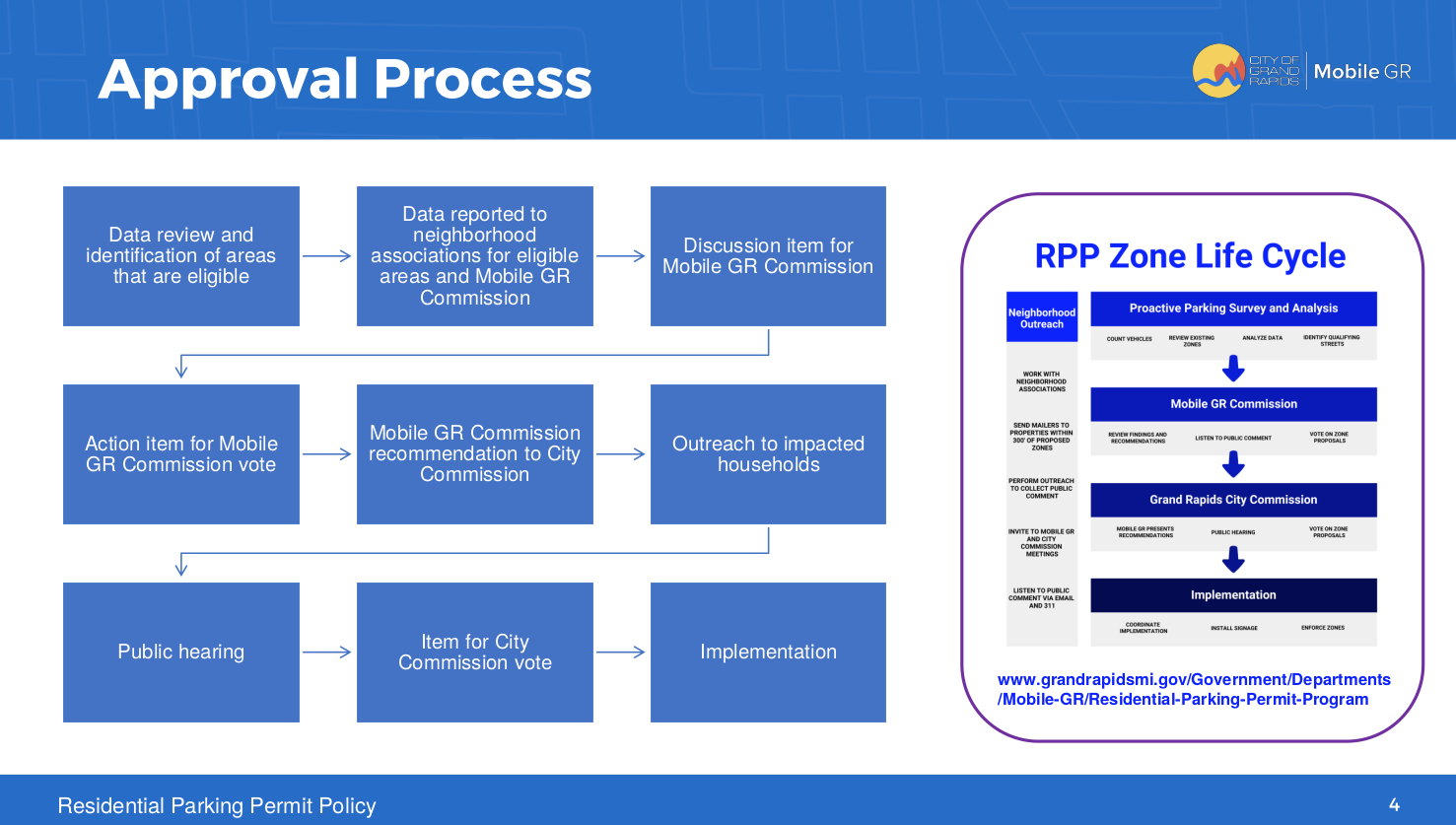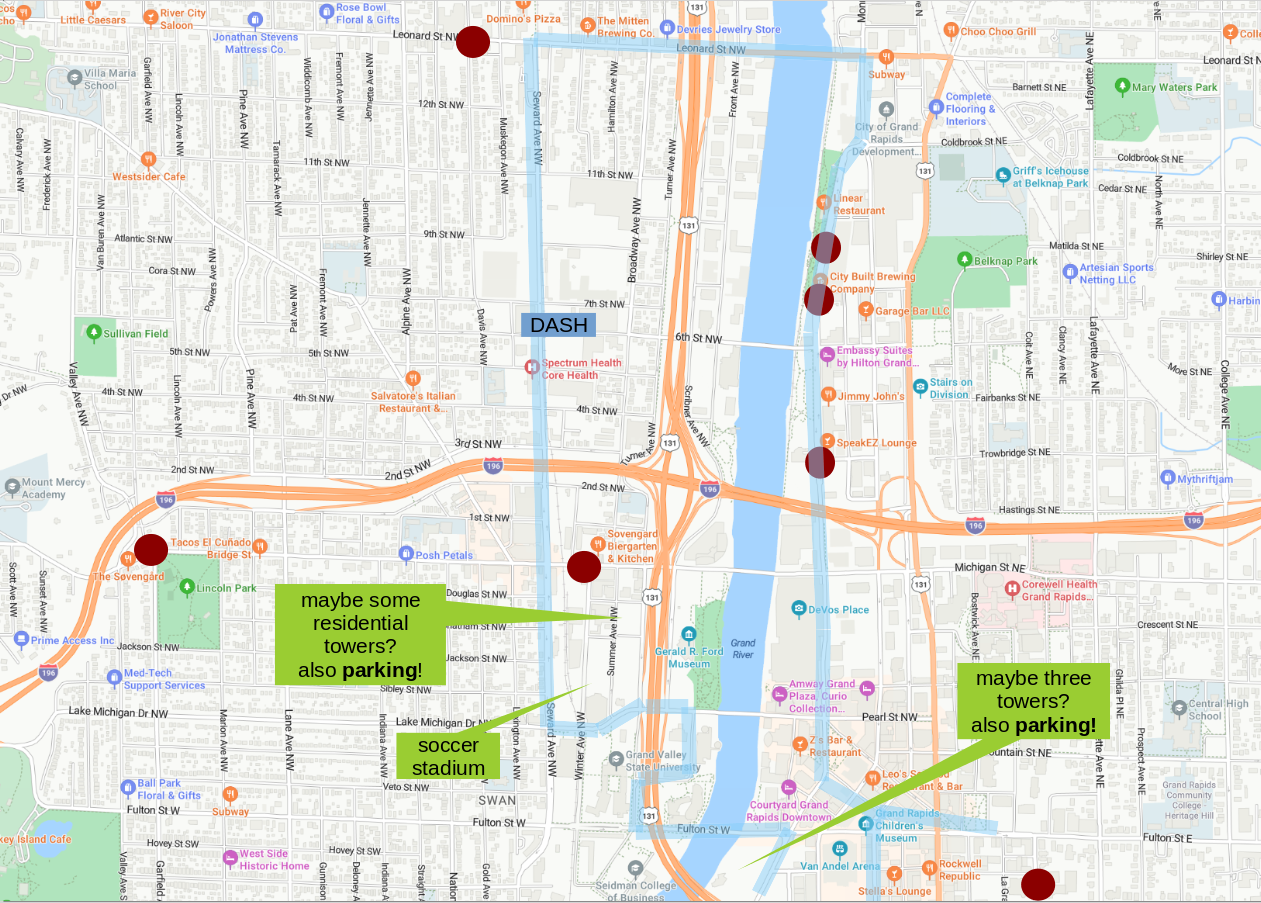Mobility Update: 2024-10
There is a lot, very quietly, happening in the transportation space. On the surface not much is changing, other than related to ride-hailing / car-sharing, which I will cover first. Meanwhile, down below in the civic forges the bellows are pumping; we are either shaping the beginnings of a different future, or at least witnessing the death gasps of the status-quo. If voters choose wisely next month the stage is set for change; but we’ve been here before, don’t count those chickens just yet.
Car Share & Ride Share
MobileGR’s car-share program should launch any day now; “Spring-Summer”, the intended launch time, came and went. We discussed the details of this program back in the February mobility update. Calculating the time dilation between Normal Time and Municipal Time any day now should be before the year end?
The Rapids’ ride hailing service Rapid Connect, which debuted in 2022, is shutting down on December 27th, 2024 [a Friday]. Wheels To Work, West Michigan Rides (car-pooling), and PASS shuttles will continue to operate. Car share and ride share - aka: door-to-door services - are scandalously expensive to operate in addition to being logistically complicated [rides have to be scheduled, vehicles do not naturally return to a depot, etc...]. A ride share service never achieves the load factor of even a lowest performing bus route.
Load factor is calculated by dividing the passenger miles by the total road miles traveled. The dead-head (when operating with no passengers) between a drop-off location and the next pickup can be 50% of the total miles traveled; regardless of what some county commissioners suggest Rapid buses are not completely empty 50% of the time - they should consider actually getting on one.
Parking
The city’s bond of $30,400,000 for a 340 space parking garage at the amphitheater site continues to move toward spend. Yes, that is ~$88,000 a parking space. And more parking is expected to be stacked on top by - at this point unspecified - private developers. This, in addition to the thousands of parking spaces proposed for the office tower at Monroe Ave and Fulton St. We can all look forward to unprecedented congestion. The notion of their being sufficient parking downtown, or that these developments would be designed to encourage multi-modal users and access; all such rhetoric has been quickly abandoned now that the projects are underway. It will require police officers for pedestrians to cross streets, and the buses will be slowed to a crawl. It will be faster to walk downtown than to take a bus into downtown once these are constructed. No meaningful multi-modal provisions have been proposed by the City Commission, Grand Action, the Rapid, or, well, anyone. It is difficult for supporters of these projects, myself included, who took those statements in good faith not to feel as if we got played. It looks like we will get one bike lane, along the backside of the soccer stadium, in the concrete canyon between the stadium and the interstate; any cyclist who enjoys a Blade Runner (1982) aesthetic is going to love it.
Related to the stadium development the city was considering the rolling out of a Residential Parking Permit program. This would have served to protect the principally residential area to the west of the stadium from parking squatters - those attempting to avoid paying to store their private property [their car] when attending an event. This was poorly communicated in the typical lackidasical style of the current regime and a group of calamitarians used that opportunity to whip-up people into an uninformed frenzy. The idea is now shelved. Again, in the typical style of the current regime, rather than addressing their poor communication and execution, they will revisit the policy to add “greater neighborhood involvement”.
...more process will fix it?
Pedestrian Safety
The city has been awarded $749,000 in federal funding for the installation of eleven (11) pedestrian rapid flashing beacons (RFBs) in 2026. This in addition to the thirteen (13) funded for 2025. Seven rapid flashing beacons, funded in 2023, have been installed or are being installed in this calendar year.
- Cesar Chavez & Beacon St SW
- Bridge St & Gargield Ave SW
- Eastern Ave SE at Plaster Creek Trail
- Lake Eastbrook Blvd & Camelot Dr SE
- Leonard St & Davis NW
- Fulton St E & Alten Ave NE
A pedestrian hybrid beacon has also been installed at Eastern Ave & Logan St SE.
Downtown Grand Rapids Inc and MobileGR are funding desperately needed improvements at Bridge St and Winter Ave. The improvements may include a rapid flashing beacon, curb extensions, and a raised westbound bike path. The scope of work recognizes that motorist have been using the bike lane for parking.
Additional rapid flashing beacons are anticipated for Jefferson Ave & State St SE, Monroe Ave & Trowbridge St NE, Monroe Ave & Mason St NW, and at a new midblock crossing for Boardwalk Apartments on Monroe Ave. Curb modifications will correspond to most installations.
It seems as if rapid flashing beacons have become a go-to solution, and they can be effective if appropriately paired with street and curb [re]design.
Bicycle Infrastructure
The consultant has been selected for the design and engagement for the Griggs St bike way, a project to connect the southwest and southeast quadrants of the city with 3.85 miles of bicycle infrastructure. This project, the first with such a large scope, actually connects things: four schools, an industrial area, a park, a commercial area, and seven transit routes. After a decade of small-ball and fragmentary investments, this project is refreshing.

The city is also working on cost estimates for eighteen (18) bike-way projects and a project work plan related to the effectively dormant 2019 Bicycle Action Plan. Details of the project work plan are expected in Fall of 2024, so perhaps sometime in early 2025?
There is also the Lyon & Fountain redesign and the Godfrey / Factory Yards bike lane extension. If the Godfrey extension reaches Chestnut St and the amphitheater brings connection to the railroad tracks north of Wealthy St ... we are so close to a big connection, at least from the south into downtown [then, what happens at Fulton St? yeah]
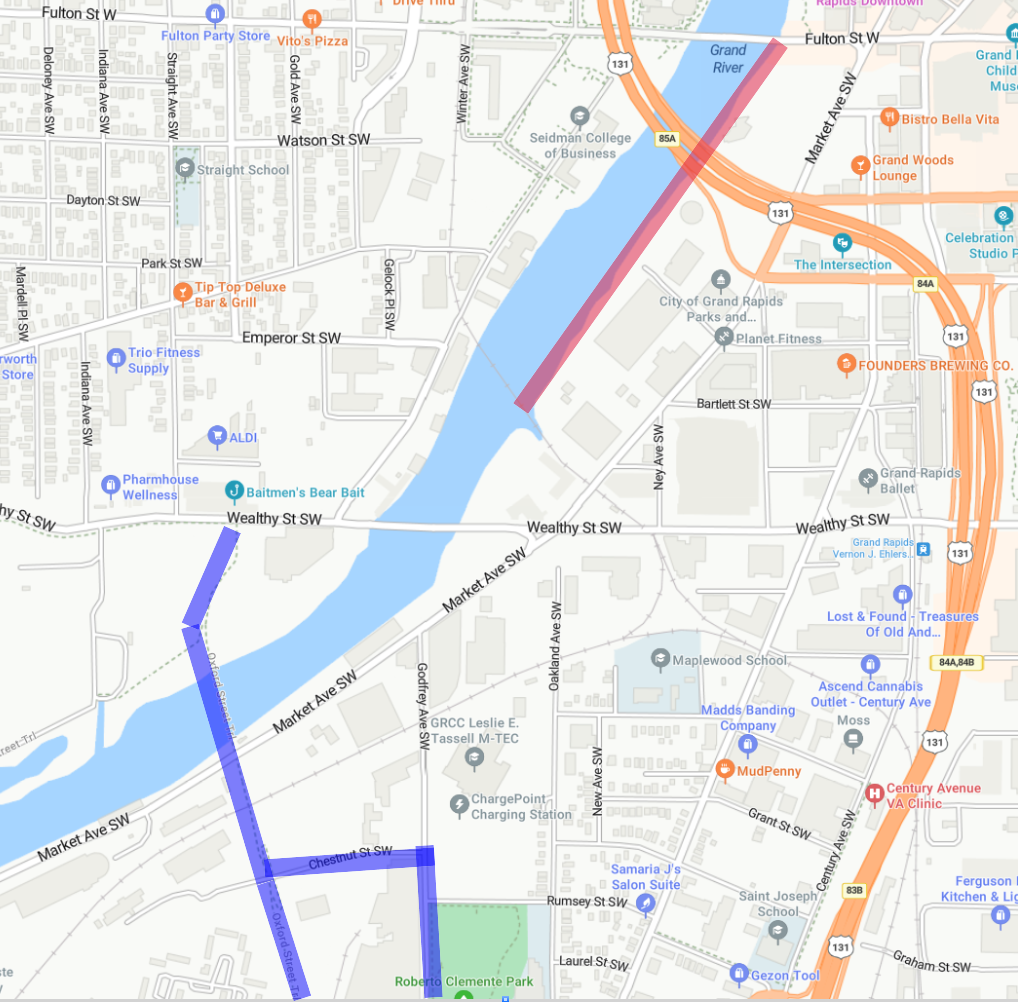
Transit Ridership
Ridership of the DASH continues to grow, significantly; up 88% in July and 97% in August. It is anticipated that the DASH will exceed 364,000 riders in 2024. Remember that number when you, inevitably, hear someone say “nobody rides the bus”; 364,000 nobodies? And that's just the DASH.
July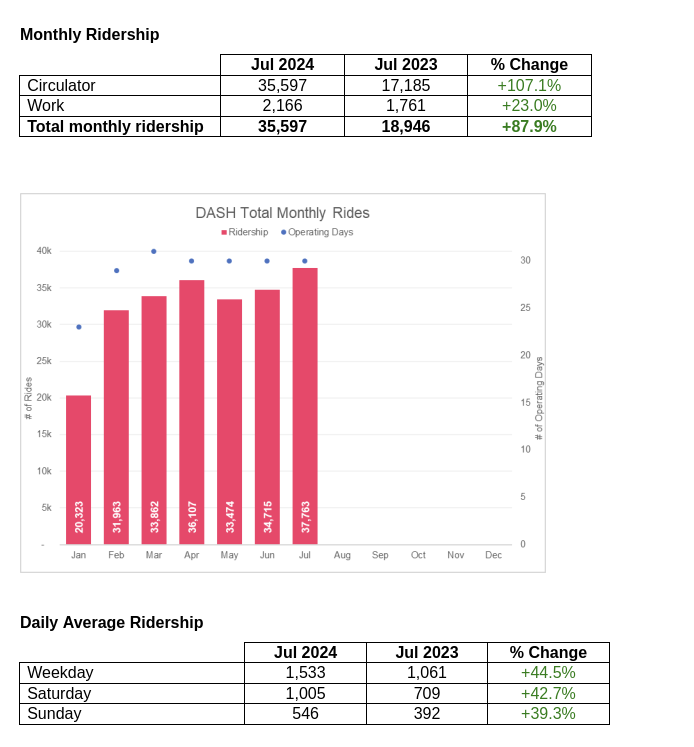 |
August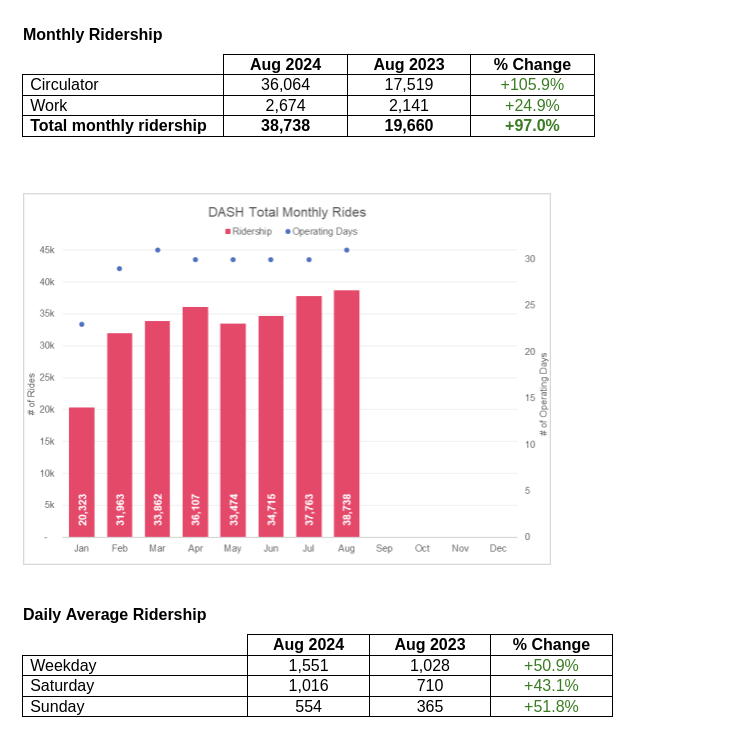 |
A criticism I often hear is that the DASH does not integrate with the Rapid’s routes, and that the DASH is principally for tourists. It is an odd critique, and it is also clearly false; the DASH stop at Rapid Central Station has the highest utilization, and the peak utilization of the DASH is during the midday.
Usage By Stop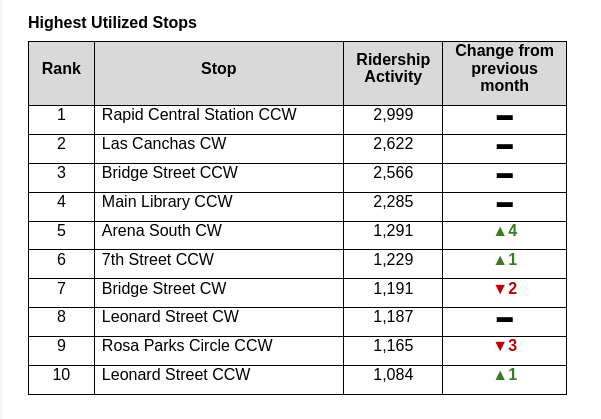 |
Usage By Hour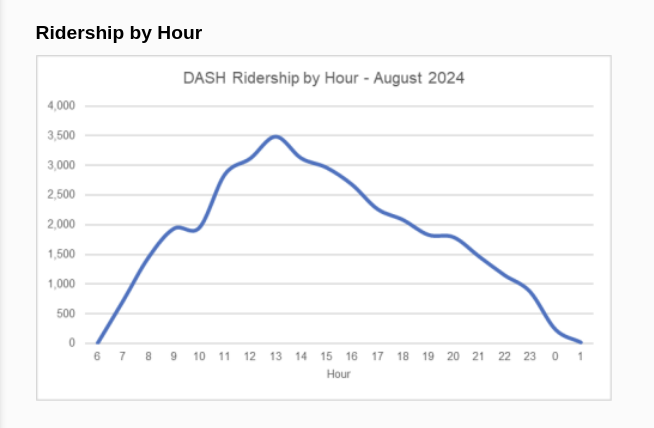 |
The DASH has become a key component in Grand Rapids’ public transportation network, and one used by Grand Rapids residents.
Another impressive aspect of the DASH is its efficiency. At $5.86/rider the DASH is, by any metric, an extremely efficient transit service. That is a lower cost per rider than seen in either other cities’ downtown shuttle networks or on the Rapid’s fixed-route system. This is certainly better than the 1:9 ratio of motordom where, on average every $1 spent by a motorist on their transportation is backed by a $9 public subsidy. Remember those $88,000 parking spaces we mentioned previously?
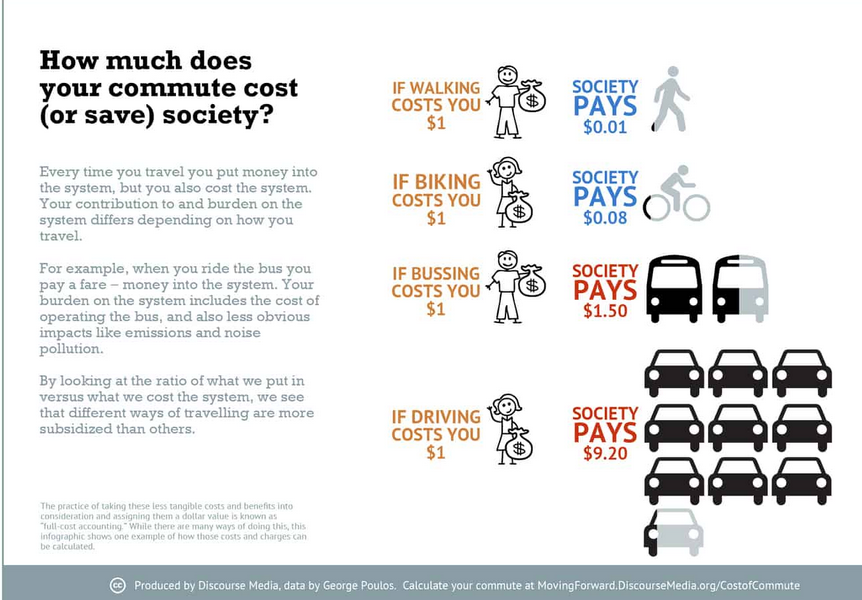
Motorists are shameless free loaders.
The DASH and the Lakerline are the primary contributors to the ridership growth on the Rapid’s network. Ridership of the fixed-route network was flat comparing August 2023 and August 2024. August 2023 had an additional weekday which can almost entirely explain the delta between the months.
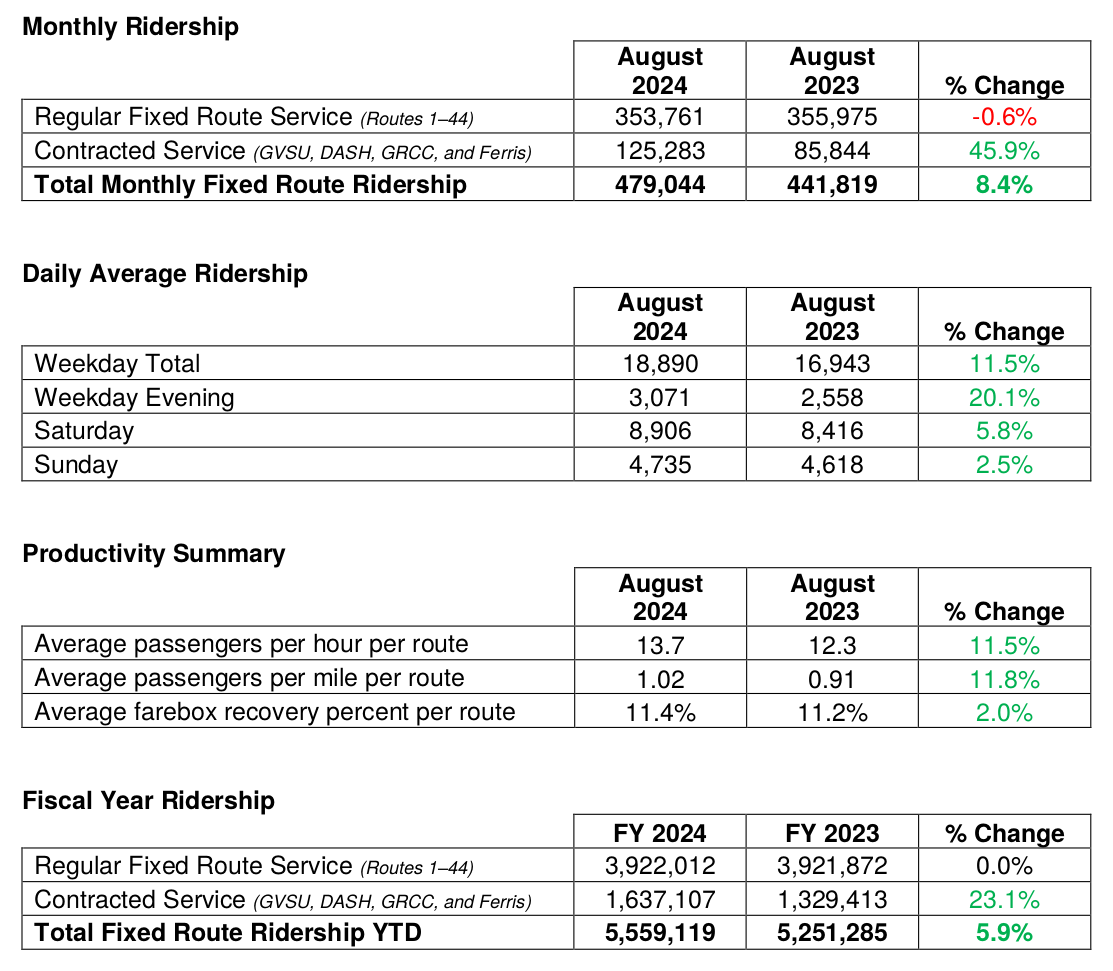
As of the end of the second quarter (June) Rapid ridership for calendar year 2024 was 3,072,910; up 4% from 2023 which had 2,956,328 rides at the same point. Transit ridership is reported quarterly, so we will not know Q3 2024 ridership until into November.
The Rapid's Solvency
We’ve talked before about the Rapid's looming fiscal cliff - what is technically referred to as a “structural deficit” - or what is more simply: when the money runs out and the music stops. The situation has improved a bit since I wrote The Beginning of The End Of The Rapid, but the cliff has moved by a count of months, not years. There’s been some patchwork funding, the cost of fuel has continued to decline as diesel buses are phased out; however, as in almost every sector, the costs of health care and benefits have soared. The Rapid’s cost for employee health care has increased 7% and the cost of employee life insurance increased 30%. The largest single line item for operating any transit service is, and always will be, staffing.
Whoever spearheaded the Rapid’s move from diesel to CNG (compressed natural gas) deserves a plaque. Diesel currently costs $4.25/gal while CNG is $1.08 per diesel gallon equivalent; a 75% savings. The Rapid uses both pipeline CNG and renewable (RNG) CNG from the city’s biodigester; meaning much of the fuel to those internal combustion engines is green energy, without the infrastructure costs and reliability issues of fleet electrification.
The largest decline in operating revenue sources? State Operating Assistance, which is the funding MDOT is obligated to provide for local transit operations under Act 51 of 1951, but which MDOT does not provide. This funding is not provided as the state legislature and the governor’s office choose not to appropriate it.
Timid conversations about funding on the local level are beginning to happen, but the Rapid's board clearly does not believe it has the support of the community. Other communities, most notably Ann Arbor, have recently passed significant transit mileage increases, yet our local leaders seem reluctant to try. There is constant talk about the need for a "regional" approach or solution to public transportation, even as the county commission clearly has no interest in the idea what-so-ever. If you have an iron stomach for suburban cliches and affluent guy arrogance you can watch the Kent County Board of Commissioners meeting from February, where the Rapid presented. I find the different strands of the conversation to be irreconcilable; making this a confounding subject. I fear, at this point, all around, we have the wrong people at the helm of the ship. They've stopped hearing anyone but themselves.
Elections matter.
The Climate Action Plan
The city has released its Climate Action and Adaptation Plan (CAAP). The transportation chapter sets seven strategies, with the substantive strategies being #2 through #5.
- Strategy #2: Expand and Protect Pedestrian Network and Amenities.
- Strategy #3: Expand Separated/Protected Bicycle Lanes and Build Out a Safe Network
- Strategy #4: Support Regional Projects that Promote Transit
- Strategy #5: Use Land Use to Promote Public Transportation Options
Strategy #2 is largely Vision Zero - which the city adopted in 2018 - and strategy #3 is the 2019 Bicycle Action Plan. Strategy #4 is, as expected anytime you see the city use the word “regional”, a grab bag of ideas about promoting commuter mode shift. There is a great deal of overlap with existing plans as well as ideas the city has demonstrated it has no intention of following through on.
Strategy #5, however, represents an ongoing and positive shift. A shift that could pay dividends if voters make wise decisions in November. Strategy #5 acknowledges the linkage between transportation (mode share) and land-use. Under Strategy #5:
- Action 1: Increase density with a range of housing types
- Action 2: Focus land use on more accessible and less car centric neighborhoods
- Action 3: Increase density via infill development
- Action 4: Increase mixed-use development
It has been documented again and again that density and cities are the single most effective solution to addressing climate change.
- How housing density can help keep cities cooler
- If You're Ignoring Transportation, You're Not Much of a Climate Mayor
- For The Climate And Fairness, Take Buses And Sidewalks Before Electric Cars
- We can’t beat the climate crisis without rethinking land use
- Denser cities could be a climate boon - but nimbyism stands in the way
- .. I could go on and on.
Composting and recycling are good things to do; but the meat on the bone of addressing climate change is land use, and the marrow is urban density. It is encouraging to see this in a city document, stated so plainly. If only the new Master Plan had that kind of clarity ...
The Master Plan
The draft Master Plan has chapter #4 about mobility, titled "Balanced Mobility"; it is sixteen pages. Chapter #4 starts at page 60. Right of the top, there is the problem of "balance". How does the concept of "balance" guide policy? What isn't a balance; if $9 are spent of building parking, and $1 on bus shelters, that is a balance.
Does the infrastructure we are starting with, when the plan is inevitably adopted in December, in balance between motorists and someone trying to cross the street?
Is someone operating a 2,000lb vehicle with 400 horsepower and airbags existing in some type of parity with the cyclist on the road?
Do the investments ($88,000 for a parking space?) by the city represent a kind of parity between motorists, pedestrians, cyclists? Between services for residents vs. services for visitors vs. services for commuters?
The public comment period of the draft Master Plan has a week left. If you make no other comment on this document please consider commenting on the meaningless of "balance". The comment form is 👉here👈. "balance" is meaningless; paid experts can do better.
The chapter itself is not bad, it enumerates all the items you'd expect:
- 4.A.1 Improve intersections and corridors with the most serious and fatal traffic crashes
- 4.A.2 Address high-crash intersections and corridors through quick-build interventions
- 4.A.3 Provide citywide education and engagement about mobility projects and issues
- 4.B.1 Make strategic investments in bicycle facilities
- 4.B.2 Support shared mobility models to increase transportation choices
- 4.B.3 Promote electric bicycle and vehicle ownership
- 4.B.4 Support programs that encourage travel options other than personal vehicles
- 4.B.5 Support collaboration between businesses, organizations, and communities to expand commute options
- 4.B.6 Continue to invest in transit stop amenities
- 4.B.7 Work with Michigan Department of Transportation (MDOT) to address highways where they create barriers to, safe walking, bicycling and transit access
- 4.C.1 Reduce minimum parking requirements to support compact growth patterns [notably, it does not say "eliminate"]
- 4.C.2 Limit the size of surface parking lots
- 4.C.3 Establish mobility hubs at key nodes of activity including neighborhood nodes, employment centers, and transit-oriented destinations
- 4.C.4 Develop comprehensive curbside management guidelines that address loading zones, drop-off/pickup zones, on-street parking, and bicycle/scooter parking
- 4.C.5 Consider modes of travel other than cars in the development review and approval process
- 4.C.6 Ensure new developments maintain walk-able and bike-able roadway networks with appropriate access to transit
- 4.C.7 Support implementation of the Vital Streets Plan
It all sounds good. Much of this was in the 2002 Master Plan, such as the concept of Mobility Hubs (4.C.3), and nothing happened. In the end the plan is just a document; elections and advocacy will determine what happens. But "balance"? Come on, try harder.
State Transportation Funding
In the end, it is all about what we as a society choose to fund. So far the Whitmer administration has proposed transit funding cuts at every budget cycle, meanwhile saddling Michigan with billions in debt to continue expanding roads even as population declines in most of the state. Too many of the state's leadership still believe the path to fiscal solvency, even population growth, is reached by building out ever more suburbs; their entire strategy is the notion that young people who left Michigan will want to return when they have children, to nice house on a cul-de-sac, in a "good" school system. They should check in on America's birth rates, as just one data point.
Meanwhile there is better news over in the legislature. This year saw the first Transit Caucus in many decades. And they've delivered a package of bills to the state house which would refactor the state's bloated and obsolete scheme for corporate graft, ah..., I mean "incentives", known as SOAR into a set of channels each which would direct the funds to investments which would make the state more competitive and attractive. One these those channels would direct an additional ~$200,000,000 to the state's transportation infrastructure; and I mean transportation, not "roads"
- HB5770 : Creates a trust fund to be called the Mobility Trust Fund (the MTF).
- HB5768 : Updates the Michigan Income Tax Act, replacing the SOAR fund with distributions to several purpose specific funds including the new Mobility Trust Fund.
- HB5769 : Creates a new grant program for public transportation operations, this program would distribute the funds from the Mobility Trust Fund under a new authority, the Transformational Projects Authority (TPA) within MDOT (Michigan Department of Transportation). The TPA would have a five member board. Potential recipients are any public transportation provider [as defined by the Regional Transit Authority Act] other than a street railway. The TPA would distribute 20% of the deposits into the MTF each years as supplemental operating assistance grants; these grants would be made in accordance with the rules of the 1951 Act 51 regarding the Comprehensive Transportation Fund (CTF).
This would be an enormous step forward, potentially, for public transportation funding in Michigan.
See: How Michigan Funds Local Public Transportation, STGR
At least two of the five members of the TPA's board would be required to have "expertise" in public transportation; and only authorities created under the Metropolitan Transportation Authorities Act - such as the ITP [aka: The Rapid] - would be eligible for funds. That creates some clear guard rails against fiscal hi-jinkery, limiting the ability of funds to wander off to corporate projects such as highways which magically recharge electric vehicles as they drive.
The existing funding for local public transportation - the “Local Bus Operating Assistance '' - in 2022-2023 was $201,000,000. The new MTF's 20% of $200,000,000 would be $40,000,0000, a potential 19.9% increase for local transit operators. Interestingly, that would still be less than MDOT owes local transit operators if the the existing CTF was fully funded, as MDOT provided only 58% of the amount requested by urban transit operators in 2022-2023. Yet, progress is progress; repairing MDOT's core funding schema - known as Act 51 of 1951 which created the CTF, etc... - is not on the table; it is - ironically - a political third rail.
Related
- Legislative Summary of HB5768, HB5769, HB5770, PDF 2024-06-04
- Legislative Analysis of SB559, SB562, HB5768, & HB5769, PDF 2024-06-20
- Legislators aim to get serious about improving public transit , Crains 2024-02-26
- Mass transit wins big in new plan to retool Michigan corporate subsidies, BridgeMI 2024-05-30

